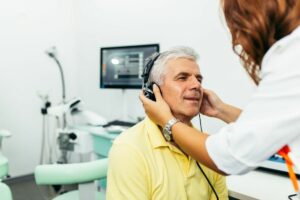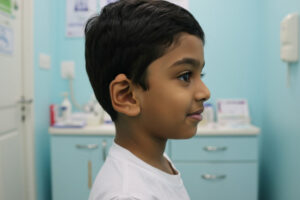Getting a new ear piercing is exciting, whether it’s your first or an additional one. For many, it’s a way to express personality, culture, or simply celebrate a moment. But behind the sparkle of new earrings lies something often overlooked: a piercing is, after all, a small wound. And like any wound, it needs the right care to heal well.
As an ENT surgeon, I’ve seen how small piercing issues, when ignored, can turn into painful infections or complications. The good news? Most of this can be prevented with a little extra care and the right information.
Let’s break down what causes ear piercing infections, what to watch out for, and when it might be time to seek medical help.
What Causes an Ear Piercing Infection?
Infections usually occur when bacteria enter the small wound created during the piercing process. Several common factors can increase this risk:
- Touching with unclean hands – Germs from your fingers can easily transfer to the fresh piercing.
- Unsterile piercing tools or poor technique – Equipment that isn’t properly sterilized or piercers who don’t wear gloves can introduce bacteria.
- Skipping aftercare or using harsh products – A piercing needs gentle, regular cleaning. Harsh cleansers like alcohol or hydrogen peroxide can irritate the skin.
- Tight earrings – Earrings screwed on too tightly can trap moisture and reduce airflow, slowing healing.
- Sharp posts or frequent twisting – These can irritate the piercing site and delay recovery.
- Removing earrings too early – This can cause the hole to close and trap bacteria inside, leading to infection.
Common Symptoms to Watch For
Some tenderness, mild redness, itching, or a bit of crusting is completely normal during the early stages of healing. These are signs that your body is doing its job. However, when symptoms go beyond this and become more intense or uncomfortable, it may point to an infection. Here are some signs to look out for:
- Redness or Swelling: It’s common to have slight redness in the beginning, but if the skin around the piercing becomes very sore, puffy, or the redness spreads, it’s a cause for concern.
- Pus-like Discharge: A thick yellow or green discharge with an unpleasant smell is usually a sign of infection. Clear or slightly white fluid can be normal in the first few days, but pus is not.
- Ongoing Pain or Tenderness: If the area continues to hurt or feels sore even days after the piercing, it’s worth getting it checked.
- Itching and Burning: These sensations might indicate irritation or the early signs of an infection, especially when they appear along with other symptoms.
- Heat: If the area feels warm or hot to the touch, it may mean the body is reacting to a developing infection.
- Fever or Feeling Unwell: In rare but more serious cases, the body may respond with a low-grade fever or a general feeling of being unwell. This requires medical attention.
- Stuck Earring: If the earring or its clasp gets embedded in the skin or becomes difficult to remove, it’s important to have it assessed by a professional.
When to Seek Help
While minor earlobe infections can often be managed at home, you should see a doctor if:
- There’s no improvement after 1–2 days of proper cleaning.
- Redness or swelling starts to spread beyond the piercing site.
- You develop a fever or feel generally unwell.
- The earring is stuck or embedded in the skin - don’t try to remove it yourself.
- Cartilage piercings show signs of infection, as these are harder to treat and can lead to serious complications if ignored.
- You notice a raised or thick scar forming, which could be a keloid.
How Infections Are Treated
Mild earlobe infections can often be managed at home with early and consistent care.
- Always wash your hands before touching the piercing.
- Clean the area once or twice daily using a mild, fragrance-free cleanser or a saline solution. Gently apply it with a clean cotton pad, rinse thoroughly, and pat dry with a paper towel or gauze to avoid irritation.
- Some doctors may recommend a thin layer of petroleum jelly to keep the area moist, but only use this if advised.
- Continue cleaning the area until it is fully healed, usually 6 to 8 weeks for earlobe piercings.
If symptoms worsen or don’t improve, see a doctor promptly. Early treatment can help prevent complications.
What to Avoid
- Harsh cleaning products: Do not use hydrogen peroxide, rubbing alcohol, iodine, or strong antibacterial soaps. These can dry out or irritate healing skin.
- Rubbing alcohol and antibiotic creams: Some sources mention them, but most experts advise against using them on new piercings.
- Twisting the jewelry: Avoid turning or twisting the earring. It can damage the skin and slow healing.
- Touching with unclean hands: Only handle your piercing after washing your hands thoroughly.
Can the Piercing Be Saved?
Yes, in most cases, it can. But don’t remove your earring if the piercing is infected. It might feel like taking it out will help, but doing so can actually cause the hole to close up and trap the infection inside, making things worse.
The best thing you can do is leave the jewellery in place, even while sleeping, and focus on gentle cleaning and care until the infection clears.
How to Prevent Infections
The best way to avoid piercing-related infections is to start with the right setup and follow simple, consistent aftercare.
- Choose a trained professional in a clean, licensed studio or clinic. If you’re looking for a medically safe option, we offer painless ear piercing services at our clinic.
- Ensure sterile technique – the piercer should use fresh gloves, sterile tools, and earrings from sealed packaging.
- Avoid piercing guns, especially for cartilage, as they can’t be fully sterilized and may damage the tissue.
- Pick hypoallergenic jewelry such as surgical steel, titanium, or gold to reduce the risk of irritation.
- Stick to gentle aftercare – clean with saline or a mild cleanser as advised, and avoid touching or twisting the earring unless you’re cleaning it.
- Give it time to heal. Earlobes may take 6 to 8 weeks, while cartilage can take several months.
- Stay out of pools, lakes, and hot tubs during the healing period to avoid introducing bacteria.
A Surprising Ear Fact
Did you know that infections are more common in cartilage piercings than in earlobe piercings? This is because cartilage has less blood supply, which means it takes longer to heal and is more prone to complications if not cared for properly.
Your Piercing, the Right Way
Taking care of a new piercing is the best way to avoid complications and make sure it heals safely and beautifully. With the right care and a little patience, you can enjoy your new look without the worry of infection. And if something doesn’t feel right, whether it’s pain, swelling, or simply a concern, don’t hesitate to reach out to a medical expert.
At earsurgeon.in, Dr. Shree Rao offers safe and painless ear piercing in a clean, medical setting, using sterile techniques and hypoallergenic jewelry. If you’re planning a new piercing or dealing with one that’s not healing well, we’re here to help!






